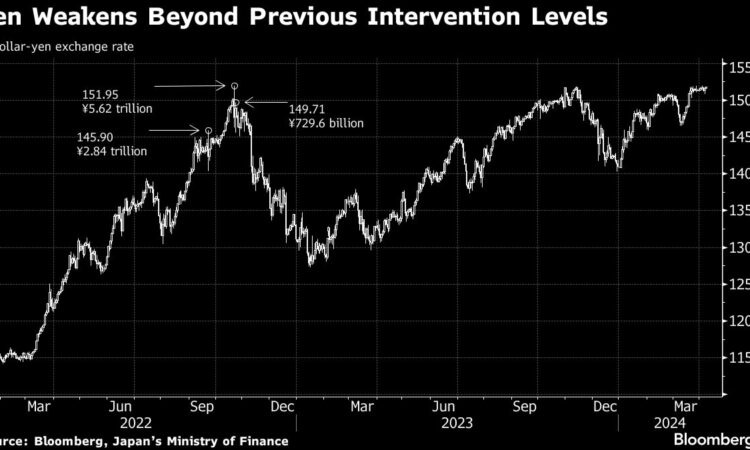
(Bloomberg) — The yen plunged through the 152-per-dollar level that Wall Street has warned could push Japanese authorities to step into the market to support the currency.
Most Read from Bloomberg
The Japanese currency fell as much as 0.8% to 152.98 versus the greenback, the weakest level since 1990. The move came after a report showed US consumer prices rose more than estimated in March, triggering a surge in US Treasury yields and the dollar as investors scaled back bets on US interest-rate cuts this year.
A flurry of verbal warnings from Japan officials that they would move to prop up the yen against speculative moves in the market has done little to stop the slide as the yen weakens in lockstep with the dollar’s strength.
“Markets are clearly calling the bluff of currency officials at the moment,” said Helen Given, a foreign-exchange trader at Monex. “If there’s not some sort of response soon I see more downside.”
The yen’s slide continued to deepen Wednesday — fast approaching the next key level of 153 per dollar — as a gauge of the US currency rallied as much as 0.9%, the biggest jump in over a year.
While top currency official Masato Kanda said that speculative moves are driving the trend, some investors are disputing that assessment as they weigh the next potential trigger point.
“It’s clearly a US dollar move and Japanese officials can’t really argue its speculators attacking the yen,” said Peter Vassallo, a portfolio manager in New York at BNP Paribas Asset Management. But intervention remains a possibility, he added. “They have been making a lot of verbal noise around intervention, so there may be an element of saving face and wanting to intervene on that basis.”
Finance Minister Shunichi Suzuki has said that he was watching the market with a high sense of urgency and wouldn’t rule out any steps to address excessive moves. Prime Minister Fumio Kishida — who is in the US meeting with President Joe Biden Wednesday — has warned against the yen’s slide, pledging to act appropriately.
“Last time they intervened in September 2022 Kishida was also in town,” said Brad Bechtel, global head of FX at Jefferies Financial Group Inc. Although he added, “I don’t think we have a big enough move in USD/JPY to spark intervention.”
A measure of underlying US inflation topped forecasts for a third straight month, likely delaying the Federal Reserve’s first interest-rate reduction. Traders are now shifting rate cut expectations to November from September, pricing two cuts this year after many had previously expected three.
While the yen weakened versus the greenback, it gained against all of other Group-of-10 currencies. It rose about 1% against the Australian dollar and 0.4% against the euro and British pound. The yen was trading at 152.93 for a dollar near midday in New York.
“The ease with which we went through 152 — the supposed line in the sand for the Ministry of Finance and the Bank of Japan — would suggest that their pain threshold maybe higher,” said Valentin Marinov, head of G-10 currency strategy at Credit Agricole.
The yen has faced renewed downward pressure recently after the BOJ ended the negative interest rate policy in March, but without providing guidance on additional rate hikes and signaling that financial conditions will be kept easy.
Authorities in Tokyo spent ¥9.2 trillion (about $60 billion) in 2022 to prop up the yen on three occasions. The yen is now much weaker than then, when they intervened in the currency market for the first time since 1998.
–With assistance from Masaki Kondo, Naomi Tajitsu, Carter Johnson and Naoto Hosoda.
(Updates market moves, adds details and comments throughout.)
Most Read from Bloomberg Businessweek
©2024 Bloomberg L.P.



